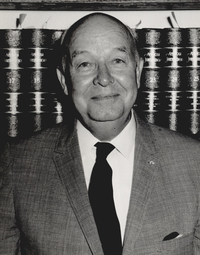|
With the dissertation behind me, I’ve managed to fill some of my spare research time with a personal project — family genealogy. I’ve been setting aside notes and data for decades, and this summer I committed to connecting the dots and ferreting out the stories. Somehow I timed this right, life-wise. My research muscles are well-trained now — in a lot of historical method, no less — and university library access really enhances the verification (and, more often, debunking) of the often suspect data found through online genealogy databases. Among the curious tales unearthed thus far, I discovered that while I might be the first “doc” in the family, I’m not the first published academic.  My paternal grandfather — Leslie L. Conner Sr., a noted Oklahoma City trial lawyer in the mid-20th century — published a single journal article, which I find rather extraordinary. It’s in my wheelhouse as a comm scholar, because it’s an artful study of non-verbal communication! Titled “The Trial Judge, His Facial Expressions, Gestures, and General Demeanor,” Les draws upon decades of courtroom experience to consider and codify numerous aspects of nonverbal communication that might interfere with the civic ritual’s foundational element of rendering fair and impartial judgment. Beyond the words spoken or entered into the textual record, he claims, the gestural and otherwise expressive capacity of the human body — “this silent communication between judge and jury,” he says — may affect a trial’s procedure and ultimate outcome. “More important than the rules of law; more important than many of the facts of a case,” he writes, “is the air or atmosphere the trial judge, consciously or unconsciously, creates during the trial of a lawsuit” (175). The article then proceeds to classify and analyze various elements of a court proceeding — the emotive display of facial movements, the political power of costuming, the importance of physical and social positioning as enacted within the space — all written as if he’s a performance-studies scholar as well as a lawyer. “The judge will react to the happenings just as any other person would, and his facial expressions will convey thoughts to the minds of the jurors,” Les writes. “It is this silent language on the part of the trial judge which frequently controls the thinking of the jury” (178). (Listen up, students: “silent language”!) It’s great ethnography, really. The paper received local news coverage (unheard of for most scholarship, trust me) and, frankly, is worthy of assignment in one of my own classes today. A few years later, in 1968, Les gave a speech based on this paper as the keynote speaker at the annual convention for the National Association of Defense Lawyers in Criminal Cases, at the Greenbriar resort in Virginia. I became a writer because my dad, another lawyer, impressed upon me the value of words, language, rhetoric & discourse. Seeing that Granddad also had a yen not just for the law but for the intricacies of human communication and meaning-making — especially in a social justice context — makes for one of the juicer apples on this creaky old family tree.
0 Comments
Leave a Reply. |
this blahg
I'm THOMAS CONNER, Ph.D. in Communication & STS, and a longtime culture journalist. Categories
All
Archives
June 2024
|

 RSS Feed
RSS Feed